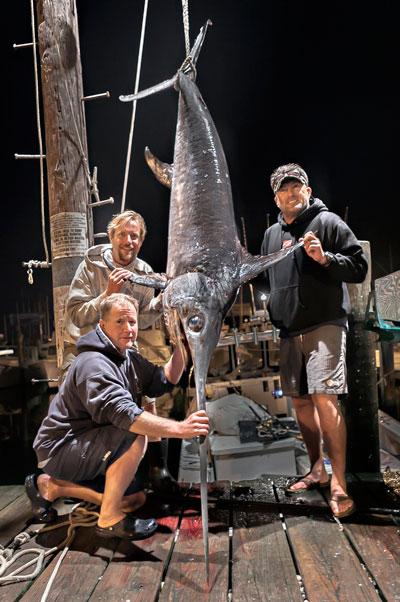A Counter-Migratory Thing

Jordan Enck and Tike Albright leaned against the split-rail fence just west of the Montauk Lighthouse on Monday afternoon beside their bikes with fat tires meant for peddling through sand. The bikes were outfitted with PVC tubes, scabbards for surfcasting rods.
“Where did you come from?” I asked. Lancaster, Pa., Amish country, Enck replied. No, they had not eschewed the internal combustion engine in favor of pedaling up the interstate to Montauk from Lancaster. They were not Amish. They had pedaled from their camper bivouac on the lower level of the state parking lot, a distance of about 100 yards.
“We ride them down to Caswells,” Albright said, referring to a productive cove with rocks aplenty to cast from about a quarter mile west of the Lighthouse. So, the Pennsylvanians knew the lay of the land and had invented a way to range into the coves without a long hike in clumsy boots and waders.
They had been making fall pilgrimages to Montauk for a number of years. Enck had arrived on Sunday, Albright had been here for a week. “I’ll stay until mother calls me home,” he said with a smile. “I’m opening a bike shop,” he said pointing to the high-end cycles, one featuring an electric motor to spare the thighs.
This time of year, the lower level of the parking lot becomes an encampment of migratory surfcasters, hardcore fishermen and women hoping to sync up with the fall run of striped bass. The lower lot is a breeding ground for fish tales.
Enck and Albright fish New Jersey and Delaware, and their own Susquehanna River, a tributary of Chesapeake Bay, home to 80 percent of the stripers that migrate the East Coast, Albright noted. The bay was “getting better,” he said, although he added that outbreaks of Pfiesteria, a type of dinoflagellate associated with algal blooms, continued to wreck the bay’s famous blue-claw crab population, and to destroy fish larvae. “It’s farmers and their fertilizers, people putting it on their lawns,” Albright said. The Pfiesteria was also the cause of the “rot” found on Chesapeake striped bass, they agreed.
They said the other Chesapeake plague took the form of “flatheads,” flathead catfish, a voracious species that “eats everything in sight,” Albright said. “They are invasive in the Chesapeake. Fishermen were supposed to kill them, but nobody did because they’re fun to catch.”
So, the two, non-Amish from Lancaster, migrated from the Susquehanna bass breeding grounds to Montauk in order to meet, with the aid of fat-tired bicycles, their hometown bass on their way back to the Susquehanna and other Chesapeake tributaries. A full-circle, counter-migratory kind of thing.
As we know, a share of Montauk’s fall run of striped bass is heading back to the Hudson River for the winter. For more than a decade beginning in 1985, Hudson River bass were off limits to market fishermen because they were contaminated by the polychlorinated biphenyls, PCBs the General Electric Company dumped into the Hudson over a 40-years period.
That era is over, but at the cost of East Hampton’s once-vital, commercial inshore bass fishery. Bass caught on the East End could be sold for food again in 1990, but the damage to the fishing community had been done. “It’s not fish ye’re buying, it’s men’s lives,” Sir Walter Scott’s famous quote resonates from the Hudson down to the Chesapeake during the fall run. Protecting the ocean and her tributaries worldwide should be the goal of everyone who casts a bucktail or sets a net.
Speaking of casting, Gary Aprea stood in first place in the wader division of the Montauk SurfMasters tournament as of Monday afternoon, but his 19.24-pound bass is not likely to hold that position for long.
Bass in the 20-to-25-pound range are being caught with regularity along Napeague and East Hampton sand beaches mixed in with gorilla bluefish feeding on mullet and bunker. Big blues are on the Gardiner’s Bay side of our peninsula, but the bass are getting chased away by seals, according to Harvey Bennett of Amagansett’s Tackle Shop.
Meanwhile, at 4 a.m. Monday morning, Chris Miller of the West Lake Marina was offshore fishing the Tails section of Block Canyon when something feisty took a bait 150 feet down. “We thought it was a bigeye,” Miller said, meaning bigeye tuna. “We fought him on a standup rod for over three hours.” It turned out to be a 256-pound swordfish.
